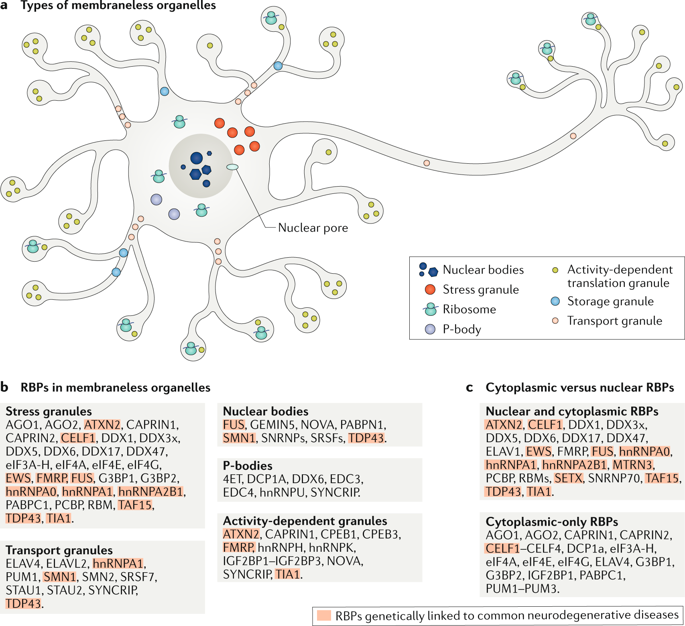当前位置:
X-MOL 学术
›
Nat. Rev. Neurosci.
›
论文详情
Our official English website, www.x-mol.net, welcomes your
feedback! (Note: you will need to create a separate account there.)
Stress granules and neurodegeneration.
Nature Reviews Neuroscience ( IF 28.7 ) Pub Date : 2019-10-03 , DOI: 10.1038/s41583-019-0222-5 Benjamin Wolozin 1, 2 , Pavel Ivanov 3, 4, 5
Nature Reviews Neuroscience ( IF 28.7 ) Pub Date : 2019-10-03 , DOI: 10.1038/s41583-019-0222-5 Benjamin Wolozin 1, 2 , Pavel Ivanov 3, 4, 5
Affiliation

|
Recent advances suggest that the response of RNA metabolism to stress has an important role in the pathophysiology of neurodegenerative diseases, particularly amyotrophic lateral sclerosis, frontotemporal dementias and Alzheimer disease. RNA-binding proteins (RBPs) control the utilization of mRNA during stress, in part through the formation of membraneless organelles termed stress granules (SGs). These structures form through a process of liquid-liquid phase separation. Multiple biochemical pathways regulate SG biology. The major signalling pathways regulating SG formation include the mammalian target of rapamycin (mTOR)-eukaryotic translation initiation factor 4F (eIF4F) and eIF2α pathways, whereas the pathways regulating SG dispersion and removal are mediated by valosin-containing protein and the autolysosomal cascade. Post-translational modifications of RBPs also strongly contribute to the regulation of SGs. Evidence indicates that SGs are supposed to be transient structures, but the chronic stresses associated with ageing lead to chronic, persistent SGs that appear to act as a nidus for the aggregation of disease-related proteins. We suggest a model describing how intrinsic vulnerabilities within the cellular RNA metabolism might lead to the pathological aggregation of RBPs when SGs become persistent. This process might accelerate the pathophysiology of many neurodegenerative diseases and myopathies, and it suggests new targets for disease intervention.
中文翻译:

应激颗粒和神经变性。
最近的进展表明,RNA 代谢对应激的反应在神经退行性疾病的病理生理学中发挥着重要作用,特别是肌萎缩侧索硬化症、额颞叶痴呆和阿尔茨海默病。RNA 结合蛋白 (RBP) 部分通过称为应激颗粒 (SG) 的无膜细胞器的形成来控制应激过程中 mRNA 的利用。这些结构是通过液-液相分离过程形成的。多种生化途径调节 SG 生物学。调节SG形成的主要信号通路包括哺乳动物雷帕霉素靶标(mTOR)-真核翻译起始因子4F(eIF4F)和eIF2α通路,而调节SG分散和去除的通路则由含缬洛辛的蛋白和自溶酶体级联介导。RBP 的翻译后修饰也极大地促进了 SG 的调节。有证据表明,SG 应该是短暂的结构,但与衰老相关的慢性压力会导致慢性、持续性的 SG,而这些 SG 似乎是疾病相关蛋白质聚集的巢穴。我们提出了一个模型,描述当 SG 持续存在时,细胞 RNA 代谢中的内在脆弱性如何可能导致 RBP 的病理性聚集。这一过程可能会加速许多神经退行性疾病和肌病的病理生理学,并为疾病干预提供新的目标。
更新日期:2019-10-03
中文翻译:

应激颗粒和神经变性。
最近的进展表明,RNA 代谢对应激的反应在神经退行性疾病的病理生理学中发挥着重要作用,特别是肌萎缩侧索硬化症、额颞叶痴呆和阿尔茨海默病。RNA 结合蛋白 (RBP) 部分通过称为应激颗粒 (SG) 的无膜细胞器的形成来控制应激过程中 mRNA 的利用。这些结构是通过液-液相分离过程形成的。多种生化途径调节 SG 生物学。调节SG形成的主要信号通路包括哺乳动物雷帕霉素靶标(mTOR)-真核翻译起始因子4F(eIF4F)和eIF2α通路,而调节SG分散和去除的通路则由含缬洛辛的蛋白和自溶酶体级联介导。RBP 的翻译后修饰也极大地促进了 SG 的调节。有证据表明,SG 应该是短暂的结构,但与衰老相关的慢性压力会导致慢性、持续性的 SG,而这些 SG 似乎是疾病相关蛋白质聚集的巢穴。我们提出了一个模型,描述当 SG 持续存在时,细胞 RNA 代谢中的内在脆弱性如何可能导致 RBP 的病理性聚集。这一过程可能会加速许多神经退行性疾病和肌病的病理生理学,并为疾病干预提供新的目标。











































 京公网安备 11010802027423号
京公网安备 11010802027423号